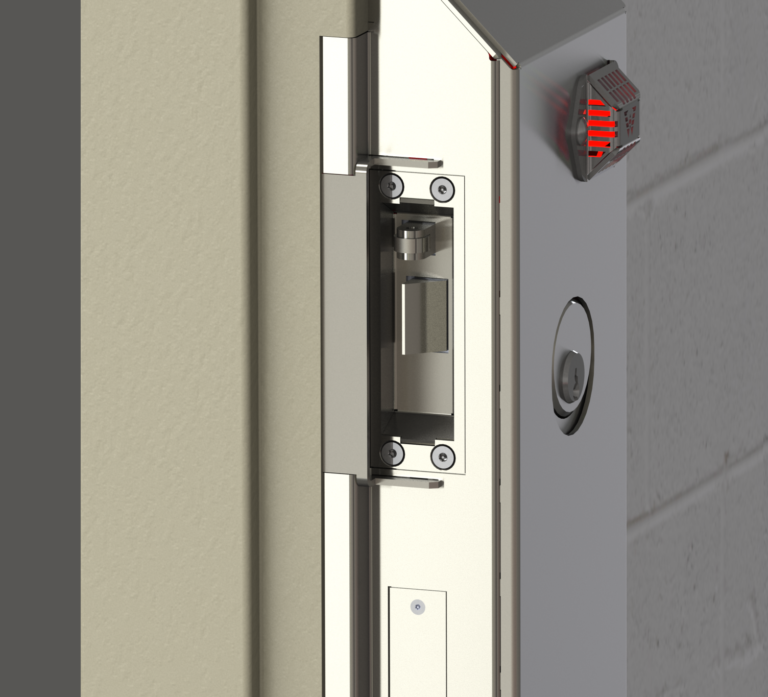Measuring Security
TJ Rogers
Correctional News: What trends are you seeing regarding security and communication systems at correctional facilities?

TJ Rogers: The biggest thing we are seeing is video visitation systems becoming standard. I think that has become standard in functionality.
CN: It seems like implementing the systems has become a hot-button issue with regards to what exactly can and cannot be allowed at facilities.
TR: I agree. It varies from state to state and there is still some concern with how it’s implemented and how it’s used.
There are some standard functionality benefits that offer a lot to a county facility. It decreases movement at the facility, it decreases staffing, and it’s a lot safer across the board. It also decreases the possibility of contraband coming into the facility. But, the underlying question is, “what functions haven’t yet been realized?”
Call buttons, increases in visitation time and other benefits have shaken themselves out, but there are other issues – such as being able to record visitations – that have not been determined in some states.
I think the future of video visitation will involve off-site visits where families could potentially visit across a network from their home computer or a site close to their home.
CN: Because there is reduced movement at facilities with video visitation, have you seen changes in the design of new facilities?
TR: The layout does change and some architectural firms’ concepts of moving visitors and inmates to visitation stations throughout the facility have changed. Some of the more traditional challenges of making concessions to public interest are still being worked out.
From a design perspective several questions arise: Where do you situate the booth inside the housing unit for the inmate? What kind of enclosure do you house the equipment in? If there is a camera, does it look over the shoulder of the inmate? Sometimes I’m not sure if those things are always taken into consideration.
CN: Are there other security or communications components that facility owners are showing interest in?
TR: We’re starting to see people with interest in PDAs (personal digital assistants), versus using a fixed-based operating station in a direct supervision housing unit.
I think there are some positives and some negatives to using PDAs. One of the positives to that approach is officers are mobile and flexible. They are not relegated to being at a fixed station. The negative that I see is it takes two hands to operate. To operate a PDA you have to hang onto the PDA itself and you have to use a hand to control it. I think it leaves an officer vulnerable, especially when dealing with an inmate.
Another problem with PDAs is durability. The protective covers that you can get for them are not really built for the detention market. Basically, without adding any other factors, if you slip and drop it, it is typically going to land on a concrete floor. However, there are some products out there that are more expensive, but they are rugged.
Also, the wireless access that is required for PDAs is in the security system network. Obviously, a wireless network could potentially be infiltrated. That’s why you build firewalls, but as we’ve seen, firewalls can be circumvented.
Another new technology that I think we are on the cusp of is IT-based camera systems. All the manufacturers are developing these systems that allow cameras to communicate via Ethernet. The video image is converted to IT, and then that image is stored on a server, recorded and distributed to monitors throughout the facility. Basically, what this is going to do is replace the traditional camera matrix – the switching mechanism – and replace digital video records. It will combine those two functions on one server.
We are a little while away from this becoming a standard item in the corrections industry for a couple of different reasons. Each manufacturer’s methodology is a little different. It’s starting to be implemented and utilized, but sometimes new technology also means future advancements that will decrease the cost and increase the functionality.
CN: Will improvements to IT cameras also be based on feedback from initial users?
TR: Yes, a lot of the companies are starting to implement this and it will be similar to the digital recording industry that took off seven or eight years ago. Initially you saw really elaborate systems that were very expensive that worked great. then there was kind of a consensus in the industry that set a standard that most major manufactures follow, which lowered the price. I think that is going to happen to IT-based cameras as well.
What functions are important are yet to be determined. For example, stitching cameras together so you can take eight cameras that view a recreation yard and compile the whole yard as one scene. I think it’s a really neat function, but do the owners feel the same why? We’re right on the cusp of that technology really starting to shape itself. When these standard functions are determined, that’s when we’re going to see a decrease in cost and an increase in function. It will be standardized.
CN: These are all interesting high-tech components that can be beneficial at correctional facilities, but how can you implement them at facilities that were built in the late ’80s or early ’90s when that technology was not widely available?
TR: The overall question is, “How much disruption can the owners take?” A lot of times this new technology, for example IT camera systems, is not warranted in an existing facility. It may not be a cost-effective solution. Basically, what we would do is replace the head-end equipment. The entire infrastructure is in place. We just need to pull the camera system out and bring the new camera system into the facility.
Older facilities typically have graphic control panels. When we upgrade those things we have to put in all-new cable to upgrade to standard network components. To put in that infrastructure that doesn’t already exist is really the challenging aspect of a retrofit or upgrade of a facility.
Typically, systems are replaced when they stop working or during an expansion project. If possible, owners need to plan ahead to replace an existing system. I think it behooves them because when we replace a system there is a ton of upfront work that needs to be done.
The actual installation is really about a third of the overall time spent developing that system. Prior to installing a new system, there has to be time for the engineer and the integration company to design it. Plus, we have to develop the software that coincides with how they operate the system. We also have to assemble and test the system before it is installed.
It is a challenge when there is a catastrophic failure of an existing system and a new system needs to be created as soon as possible. Sometimes it is hard to adjust to that need and as a result the costs are sometimes more expensive then they could be and some of that upfront thought process is not implemented.
CN: What is the most important thing facility managers should consider with regard to security and communications systems when they are preparing to build a new facility or renovate an existing one?
TR: One of the most important things to consider for renovation projects is, “How does the installer interact with the population?” Can the population be moved to another housing unit or another facility to facilitate the changing of the system and the installation of new infrastructure?
That is a labor-type issue, and in some parts of the country labor pools are not necessarily what they used to be. In that situation the cost can increase dramatically and in some respects I think that causes costs to go over budget.
CN: Are there any components of security systems that you regularly see that you wish were not there? Is there anything the regularly makes you cringe?
TR: One of the biggest things that make us cringe is proprietary technology. There are some systems out there that are very proprietary in nature. Some access control systems are completely proprietary. Once the owners get them they are hamstrung, they’re relegated to only using that type of system. It’s not as prevalent as it once was, but there are still situations that are cause for that.
Another challenge is some people are still using methods that are from the late ’80s and early ’90s. They really want to keep that ideology and they don’t really embrace easier, faster, more streamlined solutions that new technologies offer. Those folks are fewer and fewer in between, but I think some of the owners don’t see the cost ramifications associated with using older methods.
CN: What will correctional security systems look like in 10 years?
TR: I think systems have become such an integral part of the facility that they are going to continue to become easier to work with. The technology has been embraced and basically become standard.
Touch screens or graphical user interface systems are embraced and requested. By and large, they are what we see at 85 percent of projects. Standard connectivity and standard protocols are what everybody does these days. That method is going to be expanded on in the future and these systems are going to be easier to work on. More integration will probably happen with regard to mobility and flexibility while decreasing liability.
I think some of the newer things will be larger operator systems to condense more information on larger touch screens.






